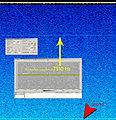Dinosaur Sounds
From Portal Puzzle Wiki
The initial Dino sounds were released with the March 1st 2010 update. 26 dinosaur##.wav files in total, some containing SSTV image, some in morse code. Two additional files, dinosaur_noise and dinosaur_fizzle were also found. The audio has been pored over repeatedly and some audio sample analysis and cleaup can be found on our Cleaned Up Sounds page.
A second batch of sounds were included in the March 3rd 2010 update with included dinosaur_fizzle2.wav and dinosaur_fizzle3.wav.
All of the original audio file can be found on our Audio Dump page.
Contents |
[edit] Analysis
[edit] dinosaur_noise
[edit] Frequencies of interest
An analysis was undertaken to find the strongest frequencies acting within "dinosaur_noise". Linear and Logarithmic curves showed sets of dominant figures, with the most being:
| Frequency (Hz) | Comments |
|---|---|
| 9092 | Largest spike before silence |
| 7862 | Very faint |
| 7812 | Very faint |
| 7657 | Very faint |
| 7502 | Largest spike in the 4000-9000Hz band |
| 3502 | Arguable. 3510 could relate to the date March 5th 2010. However, analysis of various times of the noise will yield between 3502 and 3510 |
| 360 | Another very visible wave. This was the most pronounced visible wave in the Logarithmic scale |
| 35 | The most dominant low frequency wave |
[edit] Times of interest
There are a few standout segments, not of voice data underneath, but visible clicks or something happening about 5 times. These could be indications of splices or other manipulations going on. The largest noticed broad-spectrum spikes were:
| Time(in samples) | Comments |
|---|---|
| 55402 | First broad spike |
| 422931 | Second broad spike |
| 751643 | Third broad spike |
| 1081537 | Fourth broad spike |
| 1110841 | Fifth broad spike |
[edit] Silence
Silence in the frequency ranges is located in the band of 10.567 - 15.337 KHz. All frequencies above that are likely to be high frequency poinoning from the FFT process.
[edit] Spectograms
[edit] dinosaur_fizzle
Below are images with some interesting areas of spectograms from the dinosaur_fizzle sound files. The first spectogram also looks a lot like Dinosaur 26.
[edit] dinosaur_noise
Another spectogram of "dinosaur_noise" shows an interesting anomalous frequency that dominates the noise. This frequency is 3510 Hz, which can be analyzed as March 5th 2010 (the date that Portal 2 was announced).
Another suspicious line appearing on the spectogram occurs at 7510 Hz, and assuming this follows the same convention as the 3510 Hz noise, could be interpreted as July 5, 2010.
A full spectrogram of the "dinosaur_noise" sound looks to be an image of a horizon. Perhaps this could aid in cleanup?
full spectrogram of dinosaur_noise.
this is ebtksync when you match the word "satanic" from "The Big Issue" while passing the large cross on highway I-40 south. It ends when the wires leave at "lanyard." I think this is legit because the gas station was crawling with cops and other hipsters with burning-boat Uhauls . |
[edit] dinosaur22
At the end of dinosaur22, the SSTV image becomes distorted. A spectogram of this region shows what appears to be three people, and one may be wearing something similar to an HEV suit.
Another look at the end of dinosaur22 shows what could be a number 5 hidden in the sound.
[edit] Contribute
If you want to contribute making spectograms, you can! They can be viewed with programs such as Audacity[1] or specialized programs such as Spectogram [2] (old though).
For some background info on images in sound: [3]
For those of you wanting to look at the spectograms, there is a template file you can use to check if your software is use-able:
(done with Coagula [4])
[edit] Steganography: dinosaur_noise.wav
There's a fair bit of debate as to the content of dinosaur_noise, but an idea popped up on #portal-audio that there may be something hidden inside the actual wav file itself. The most common audio steganography method is LSB or Least Significant Bit.
If at some point during the ARG least significant bit steganography is required, the source code is posted below. (C++. Written by thaipos) It can be easily adapted to extract the least significant bit of any file, but as mentioned above LSB steganography is more common in audio files.








